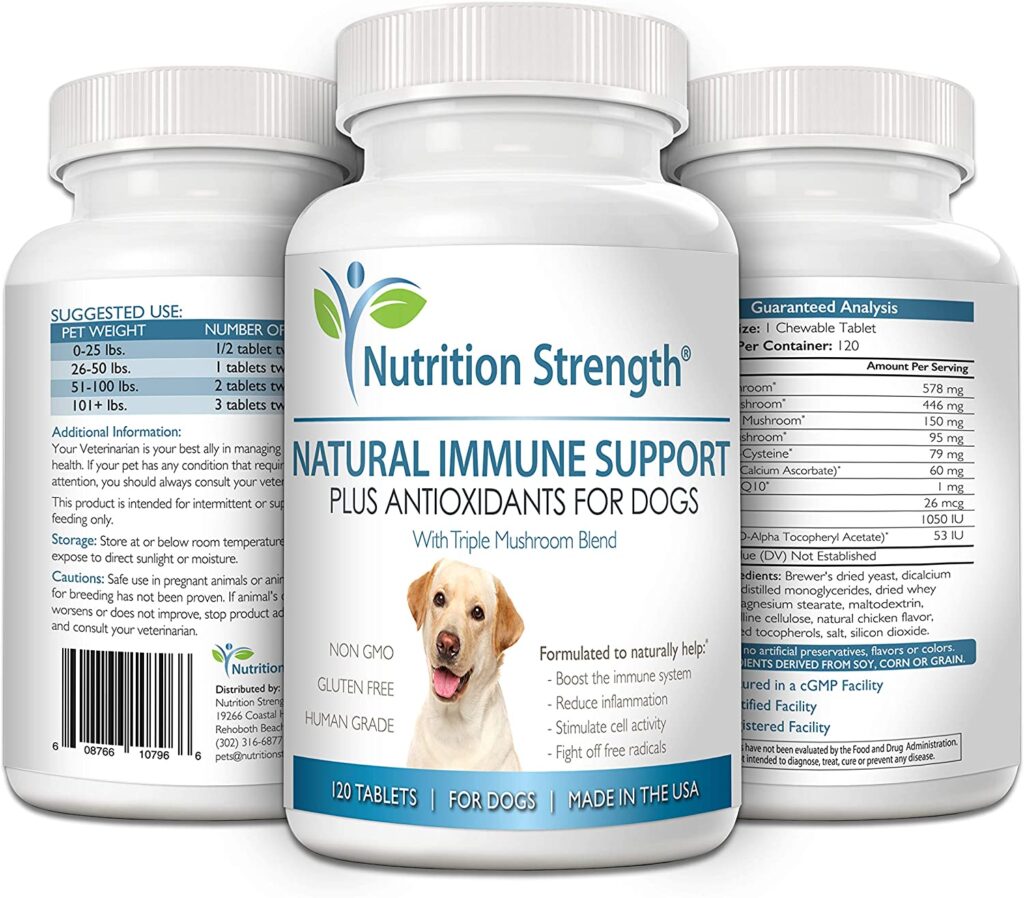Distemper in Dogs: Can We Prevent It?
Distemper in dogs is one of the most dangerous illnesses your four-legged friend may get. It is a highly infectious and frequently deadly condition that affects dogs all around the globe.
It impacts many physiological systems, including the neurological system, the brain and the spine. Though its incidence has decreased significantly due to efficient immunizations, distemper cases and outbreaks occasionally occur.
Here are the facts, symptoms, treatment choices, and preventative strategies that every dog owner should know when he thinks about a distemper in dogs.
Table of Content
- What Is Canine Distemper?
- How Is Canine Distemper Spread?
- What Are the Symptoms of Canine Distemper?
- Can a Dog Recover from Distemper?
- Diagnosing Distemper in Dogs
- Distemper Treatment for Dogs and Puppies
- Preventing Distemper
- Lasting Health Issues from Canine Distemper
- The Takeaway
- Nutrition Strength Immune Support for Dogs
Check out our Nutrition Strength Immune Support for Dogs here.
What Is Canine Distemper?
If your dog is up to date on his immunizations, you should be acquainted with canine distemper. Along with the parvovirus, canine adenovirus and rabies vaccinations, veterinarians consider the distemper vaccine a core immunization.
The canine distemper virus causes the widespread condition called distemper in dogs. Animals are often infected by direct contact with virus particles in the secretions of other affected animals (generally via inhalation).
As the virus does not stay in the environment for long, indirect transmission through dishes or other items is uncommon. For many weeks after recovery, treated dogs may shed the virus.
Puppies under four months (before vaccines are completely protective) and unvaccinated dogs are the most vulnerable. Because canine distemper exists in wild animals, interaction with wild animals may spread distemper to domestic dogs.
The illness is very infectious and has the potential to be fatal. It infects the host and causes severe sickness by targeting many bodily systems, resulting in a broad infection that is difficult to cure.
How Is Canine Distemper Spread?
Canine distemper may be acquired in three ways:
- By coming into physical touch with an infected animal or item;
- By airborne exposure;
- Through the placenta.
Like the common cold in people, canine distemper is transmitted by direct touch or airborne exposure. When an infected canine or wild animal coughs, sneezes or barks, aerosol droplets are released into the environment, infecting neighboring animals and surfaces such as food and water bowls.
The good news is that the virus does not survive in the environment for long and can be killed by most disinfectants. The bad news is that distemper-infected dogs may shed the virus for months, putting other canines at risk.
Distemper may also infect wild animals such as raccoons, foxes, wolves, coyotes, skunks, ferrets and mink. This implies dogs are at risk of contracting the illness if there is a distemper epidemic in the local animal population, even if they do not encounter other dogs.
Female dogs may also pass the virus to their pups through the placenta, so it is critical to completely vaccinate any dog you want to breed.
What Are the Symptoms of Canine Distemper?
Distemper in dogs exhibits various symptoms depending on the stage of the illness in their body. When a dog gets infected, the virus first replicates in the lymphatic tissue of the respiratory tract.
After that, it spreads to the remainder of the dog’s lymphatic tissue, respiratory tract, GI tract, urogenital epithelium, central nervous system, and optic nerves. This causes two phases of symptoms.
Stage One
Distemper in puppies generally begins with watery to pus-like discharge from the eyes, fever, lack of appetite, and clear nasal discharge.
Most dogs have a fever three to six days after being infected, but the severity and how the pet responds determines the early symptoms. In general, the following symptoms are related to canine distemper during the early stages of the disease:
- Fever;
- Clear nasal discharge;
- Purulent eye discharge;
- Lethargy;
- Anorexia;
- Coughing;
- Vomiting;
- Diarrhea;
- Pustular dermatitis (rarely);
- Inflammation of the brain and spinal cord.
Let’s assume that a dog survives the acute stage of distemper. In that case, he may develop hyperkeratosis of the paw pads and nose, earning distemper the term “hard pad sickness.” This distemper symptom causes the pads of a dog’s feet to stiffen and grow, which may be painful.
A secondary bacterial illness that strikes when a dog’s immune system is impaired by the distemper virus is one of the numerous risks linked with distemper in dogs. Secondary bacterial infections may cause respiratory and gastrointestinal symptoms such as:
- Vomiting;
- Diarrhea;
- Difficulty breathing;
- Change in respiratory rate;
- Pneumonia.
Stage Two
As the illness advances, some dogs suffer neurological symptoms and target the central nervous system. These signs are especially concerning for owners:
- Head tilt;
- Circling;
- Partial or full paralysis;
- Seizures;
- Nystagmus (repetitive eye movements);
- Muscle twitching;
- Convulsions with increased salivation and chewing motions;
- Death.
Depending on the severity of the condition, dogs may exhibit any or all of these symptoms. Distemper is generally deadly, and dogs who survive usually have persistent, incurable nervous system damage.
Can a Dog Recover from Distemper?
Dogs may survive distemper infection, but they frequently acquire permanent crippling neurological system disorders. Adult dogs are more likely than pups to survive the illness. Because puppies are more sensitive to viral diseases, the sickness is usually deadly.
Distemper may result in long-term seizures and severe chronic pneumonia that is excruciatingly painful and difficult to manage, even with medical treatment.
The illness may be shed by dogs for up to six months, making seclusion difficult and increasing the risk of contagious transmission. Many dogs who actively shed the virus have a neurologic, respiratory and gastrointestinal illnesses.
Diagnosing Distemper in Dogs
Your veterinarian will evaluate your dog’s health history, immunization history and any physical exam findings when diagnosing distemper in dogs.
As distemper is so widespread and infectious, every young puppy who exhibits symptoms and hasn’t been immunized is possibly infected. In these cases, efforts must be taken to isolate your pup.
Distemper symptoms in dogs may be confused with other viral disorders such as parvovirus, kennel cough and meningitis. If you feel your dog is sick, you should soon take them to the doctor.
Your veterinarian will most likely order lab tests to establish a diagnosis, including blood chemistry, complete blood count, fecal parasite checks and parvovirus testing.
They may also suggest further blood testing for distemper. If your vet suspects pneumonia, he or she may also order chest radiographs for your dog.
Distemper Treatment for Dogs and Puppies
Positive cases of canine distemper virus need hospitalization and isolation from all other animals throughout the viral shedding phase. Canine distemper treatment at home should continue after being discharged with rest and lack of stressing factors.
Distemper therapy for dogs comprises supportive care for clinical indicators and varies based on the dog’s symptoms. The following are the most prevalent canine distemper treatment options:
- Respiratory assistance for severe pneumonia. Many dogs have respiratory difficulties, discomfort during expiration and inhalation and persistent coughing. These symptoms are potentially fatal, necessitating oxygen treatment, anti-viral medicines, antibiotics and hospitalization.
- They also need support for severe diarrhea and vomiting, which may result in dehydration. Canine distemper virus may damage the immune system, leading to subsequent bacterial infections, septicemia, disseminated intravascular coagulation (DIC) and death in certain circumstances. In many instances, intravenous fluid treatment (to avoid dehydration), anti-vomiting drugs, antibiotics, probiotics, intravenous nutritional support and gastrointestinal protectants are required.
- Supportive care for persistent seizures is totally needed. These convulsions may linger for many minutes and cause irreparable brain damage or death. These patients require hospitalization and observation, as well as an anti-seizure medication.
Preventing Distemper
Vaccination may successfully prevent distemper. Dogs should be vaccinated as pups, no sooner than 6-8 weeks old and then every 3 – 4 weeks until they reach the age of 16 weeks. A booster is given one year later and then every three years.
Puppies should avoid contact with other dogs and wildlife until their distemper vaccination sequence is finished. Keep an eye out for vaccination reminders from your dog’s veterinarian and set your own reminders to stay on top of your dog’s health care.
You should also keep your dog on a leash when hiking or walking to prevent encounters with animals. It’s crucial to remember that not every dog is vaccinated. So mingling with other dogs, bringing them to the puppy, or going to doggy daycare may raise their chances of contracting canine distemper.
Lasting Health Issues from Canine Distemper
Because pups are more vulnerable to viral infections, canine distemper is dangerous and frequently deadly. Adult dogs may recover from canine distemper faster.
Yet, dogs often suffer from long-term neurological or central nervous system diseases such as seizures, muscular twitching, jaw spasms, nerve damage and brain damage.
The Takeaway
Canine distemper is observed all throughout the globe. However, due to the widespread use of effective vaccinations, it is far less prevalent than in the 1970s. It persists in communities with poor vaccination rates and in stray dogs.
The virus might live in recovered carrier canines and animals like skunks and raccoons. To prevent canine distemper from resurfacing as a significant killer of dogs, we must continue to vaccinate our dog population.
Distemper disease is a dangerous condition, but it does not have to impact the health of your beloved pet. You may simply prevent your dog from distempering by following your veterinarian’s immunization recommendations and paying attention to the above-mentioned tell-tale signals.
If you have any more concerns about canine distemper, consult your veterinarian. Contact him if you believe your dog is suffering from canine distemper.
Nutrition Strength Immune Support for Dogs
Check out our Nutrition Strength Immune Support for Dogs here.
Nutrition Strength Immune Support for Dogs Plus Antioxidant, Reishi, Shiitake, Maitake, Turkey Tail Mushrooms for Dogs, with Coenzyme Q10, Nutritional Support for Dogs, 120 Chewable Tablets is a delicious mix of tasty ingredients, which is designed to help strengthen your dogs’ immune system and keep your pet healthy.
Our highly-rated immune booster for dogs tablets may help keep your dog in top health by:
- Supplying a nutritionally concentrated synergistic blend of reishi, maitake and shiitake mushrooms‚ which, as a number of studies have found, are strong immune enhancers.
- Helping your pet’s immune system with the proteoglycans and polysaccharides from the mushrooms — a nutritional dog immune builder.
- Raising energy levels to keep your dog attentive, active and enjoying life.
- Promoting your dog’s immunity with a strong blend of antioxidants found in coenzyme Q-10, green tea and selenium.
Used daily, our potent immune booster for dogs nutritional supplement can help to gradually strengthen your pet’s immune system and restore their natural balance.
Nutrition Strength’s tablets feature ingredients that can help to restore joint health and enhance flexibility and range of motion.
Image source: Wikimedia / Tim Massey.




